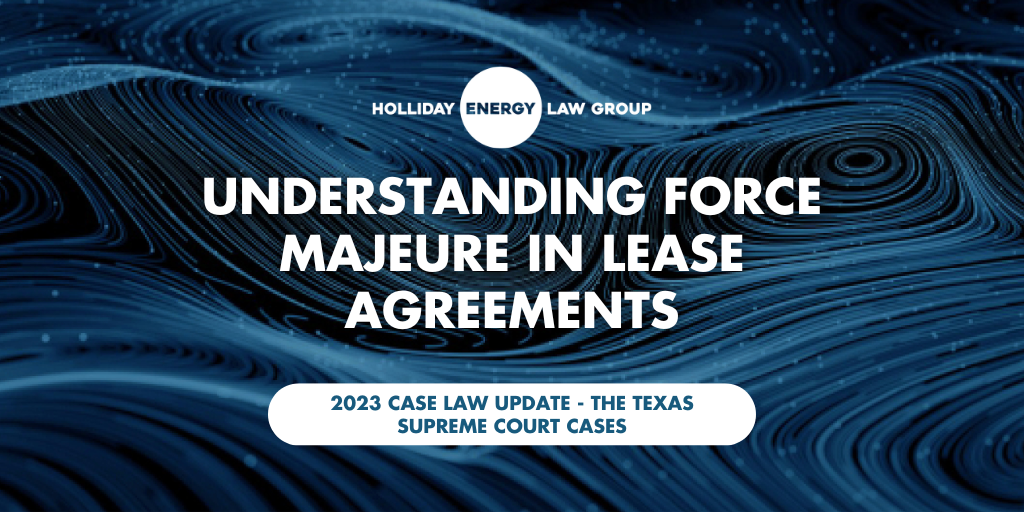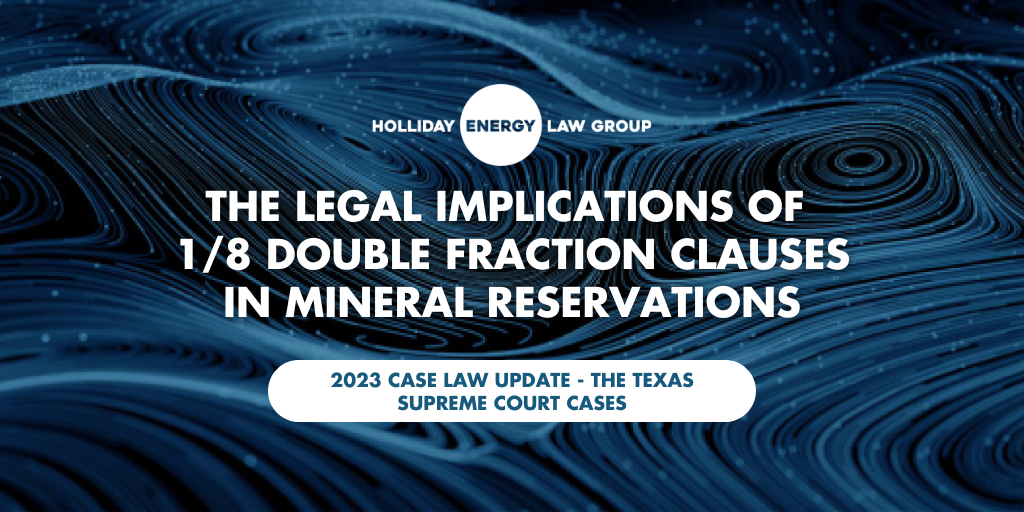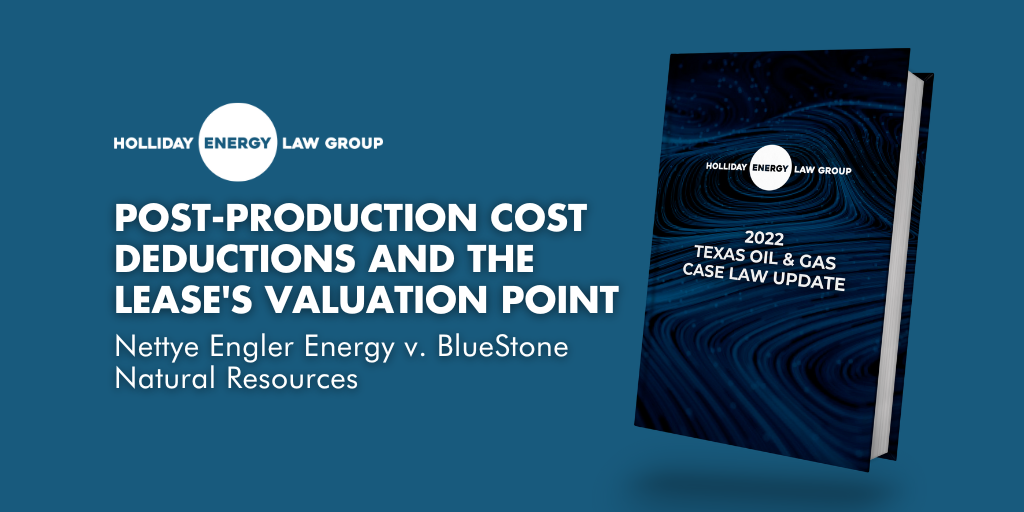Understanding Force Majeure in Lease Agreements | Point Energy Partners Permian, LLC v. MRC Permian Co.

Point Energy Partners Permian, LLC v. MRC Permian Co., 669 S.W.3d 796 (Tex. 2023). Force Majeure Clause.
Key Takeaways
- A force majeure clause is a savings clause designed to prevent automatic termination of a lease because of an unexpected event.
- A force majeure clause will not take effect, and excuse performance or prevent termination, when the force majeure event is not the actual cause for delay or missing deadline.
The Lessors signed four identical leases (collectively, the “MRC Lease”) in 2014, leasing approximately 4,000 acres in Loving County to MRC Permian Company (“MRC”), the primary term of which expired on February 28, 2017.[1] The MRC Lease included a retained-acreage clause that would “‘automatically divide’ into separate production units and terminate” after the end of the primary term.[2] The retained-acreage clause allowed the lessee to retain ‘production units’ up to 320-acres for a horizontal oil well with a lateral greater than 5,000’ in the producing formation.
The lease also contained a continuous development clause (“CDEV”), which allowed MRC to extend the MRC Lease’s primary term (and thus delay termination and operation of the retained acreage clause) by engaging in a continuous-drilling program. In order for the lease to remain in CDEV, MRC was required to spud a new well “a new well every 180 days from the spud date of the last well.” [3] If a well was spud within 180-days of the primary term’s extension, the 180-day period would tack back to the last spud date. If MRC did not maintain CDEV (i.e. did not spud a new well within the 180-day window), the MRC Lease would automatically terminate.[4]
“MRC drilled five horizontal oil wells” within the primary term, with the last one (the “Totum well”) having been spud on November 22, 2016.[5] Based on the 180-day CDEV, MRC “had until May 21, 2017, to spud a new well” (the Toot 211 well) to keep the lease in CDEV.[6] However, MRC’s operating team admittedly miscalculated the 180-day CDEV window; instead of May 21, MRC believed that the MRC Lease would terminate for failure to maintain CDEV on June 19.[7] Consequently, MRC scheduled the spudding of the Toot 211 well for June 2, 2017.[8]
When no new well was spud by May 21, the lessors executed new leases covering all lands not included in production units under the retained-acreage clause. MRC filed suit against the new lessees, alleging tortious interference with their lease, among other causes of action.
MRC had previously scheduled the Toot 211 spud date for May 11, which would have maintained the lease for an additional 180-days. According to MRC, downhole conditions in Loving County required that it utilize a specialized rig (“Rig 295”) to handle high pressures, being the same rig used to drill the Totum well. I.e. it needed to use the same specialized rig to drill all the wells in the area.
As is often the case, the drill schedule changed, albeit this time with dramatic consequences. The May 11 spud date was moved to June 2, and the rig schedule listed June 19 as the CDEV termination date. MRC’s miscalculation was caused by extrapolating the 180-day CDEV termination date from Totum well’s rig release date, instead of its spud date.
In arguing for the MRC Lease’s continued validity, MRC maintained that a force majeure event had occurred on April 21, which allowed MRC “[ninety additional] days from the resolution of that event to spud” a new well under the Force Majeure Clause.[9]
The MRC Lease’s Force Majeure Clause (“FMC”) provided that the lease would not terminate when a “non-economic event beyond the Lessee’s control” delayed the Lessee’s operations but required the Lessee to communicate the problem to the Lessor in writing within the sixty days following the claimed force majeure event. Additionally, the FMC required lessee to “use its best efforts to overcome the problem,” and resume operations within ninety days after the removal of the problem. The FMC would toll lease expiration for a maximum of 180 days and made clear that the Lessee remained responsible for any “obligation to pay sums due” regardless of such an event. [10]
MRC sent the force majeure notices “to the Lessors on June 13,” fifty-three days following the supposed event (i.e. within the required 60 days) though three weeks past the May 21 CDEV termination. [11] MRC claimed in the notices that on or about April 21, MRC experienced “‘operational issues with the rig scheduled to drill the Toot 211 well’ and ‘wellbore stability issues,’” which caused a delay in drilling the Toot 211 beyond MRC’s control.[12] These notices failed to mention the mistaken spud date and instead stated that the Toot 211 well spudding was scheduled for May 11.[13]
However, it was revealed that the April 21 delay lasted only 30 hours, while Rig 295 (the specialized rig scheduled to drill Toot 211) was drilling the Dorothy White wells for “an unrelated lease over 60 miles away.”[14]
Rig 295 had two other unrelated wells on the schedule after the Dorothy White wells and “before the Toot 211 well.”[15] At the time of the CDEV’s actual May 21 termination date, Rig 295 was drilling these other wells.[16] “MRC’s drilling superintendent and its expert” said that MRC had enough time to transport Rig 295 to the Toot 211 well site to begin drilling by early May, but chose to drill the other wells first.[17] (Attorney note: Yikes. That’s tough testimony to defend. I can’t imagine the sinking feeling that counsel felt when that statement was made in a deposition. Or, conversely, the excitement for the opposing counsel. Either way, good on them for being honest.)
On June 15, Point Energy Partners Permian, LLC (“PEPP”), responded to MRC’s force majeure notices and “explained that[,] after reviewing publicly available drilling data, it ‘questioned whether MRC’s drilling schedule sufficiently maintained the Continuous Development Program’ and therefore had taken ‘leases from the mineral owners’ on June 7[,]” 2017.[18] PEPP requested documentation of the force majeure event, but failed to dispute that MRC was entitled to retain “a leasehold interest in production units for the five wells already drilled.”[19] PEPP also stated that it had “serious concerns that any entry onto the land to drill the Toot 211 may constitute bad faith trespass” without further information.[20]
Trial & Appellate Court
Way simplifying here. MRC sued PEPP and its affiliates; PEPP countersued.[21] The trial court ruled in favor of PEPP and declared the MRC Lease terminated on May 22, 2017, as to all lands not encompassed “in a production unit.” [22] The appeals court concluded that the MRC Lease did not include any requirement that the force majeure event "had to be ‘on-lease’ or to cause MRC to miss a lease deadline.” [23]
On appeal to the Supreme Court, the main oil and gas issue was whether “the court of appeals erred in holding the [FMC] applied when [a)] only off-lease operations and plans were delayed, [b)] MRC would have missed its deadline even if the alleged force majeure event had never occurred, and [c] this failure resulted from MRC’s choices – not events beyond its control.”[24]
Texas Supreme Court
The court began by reviewing the basics of an FMC. “A force majeure clause is” defined as “a ‘contractual provision allocating the risk of loss if performance becomes impossible or impracticable, esp[ecially] as a result of an event or effect that the parties could not have anticipated or controlled.’” [25] These provisions can vary by “definition, causal-nexus requirement, remedial-action requirement, notice requirement, and grace period” that excuses or delays contractual performance. [26]
When interpreting deeds or contracts, Texas courts will look to the language actually used by the parties. Whether an FMC applies “depends on the terms the contracting parties freely” choose according to the terms of each clause.[27] The force majeure clause here:
- Must have been a “non-economic event beyond the lessee’s control.”
- Imposes a causal nexus in that it required that Lessee’s operations “be delayed ‘by’ a force majeure event.”[28]
The force majeure event has to cause the delay, and it can’t be either an economic event or within lessee’s control.
The Court focused on the causal-nexus question, examining what it meant for the “‘Lessee’s operations’ to be ‘delayed by’ a force majeure event and whether that requirement interacted with the lease deadlines.”[29] MRC identified the June 2 spud date for Toot 211 as the only operation that was actually “delayed for the purpose of the force majeure clause.”[30] However, it was undisputed that even without delay, the operation “would not have satisfied the May 21” MRC Lease deadline for continuance.[31]
MRC argued that this fact is irrelevant, however, because the FMC did not speak to about delays in “performance or compliance [with lease deadlines] – just delayed operations.”[32] Additionally, “delay” meant “to make late as to the operation’s scheduled date but not in relation to the lease deadline for that operation[,]” so a “slowdown of an operation” mistakenly scheduled to start past the deadline would activate the clause.[33]
Restated, the argument goes like this: yes, we scheduled the Toot 211 spud date for June 2, outside of the 180-day CDEV window that ended on May 21. If there had been no delay, the well would admittedly not have been spud within the CDEV period, and the retained acreage clause would have kicked in on May 21. HOWEVER, because of the April 21 issues encountered by Rig 295 on an unrelated lease, MRC encountered a force majeure event. In the face of the force majeure event, MRC then had 60 days to communicate the same to the lessor in writing, which it did on the 58th day, which 58th day was about 3 weeks after the end of the CDEV period.
Per MRC, because of the FMC tolled the CDEV expiration date. Because MRC acted in accordance with the FMC, the MRC Lease remained valid for 90 days from the end of MRC’s best efforts to remove the force majeure problem. Because it’s Toot 211 spud date was within this FMC-extended time window, spudding the Toot 211 on the June 2 date would have properly extended the lease.
The Texas Supreme Court wasn’t buying it. Based on the context of the entire MRC Lease, the Court could not agree that the “contemplated ‘delay[ ]’ of ‘Lessee’s operations’” were entirely separated from the deadlines present in the lease.[34] The MRC Lease had multiple lease termination deadlines that included a drilling-commitment, a deadline for any substitute-wells, the CDEV, the retained-acreage provision that included a requirement to file production unit designations, and “a review-of-production-units.”[35]
In order for the FMC to preserve the lease in the manner put forth by MRC, when operations were “delayed by a force majeure event” resulting in a lessee missing a deadline, then the FMC’s must be demonstrated to bridge the gap across that deadline and keep the lease alive where it would have otherwise expired, so long as the lessee complied with its terms.[36]
The MRC Lease’s FMC was intended to toll the MRC Lease expiration during a period of force majeure delay and allow the lessee time to remedy the situation and continue operations within ninety days.[37] As the court reasoned, “there would be no need for the [FMC] to provide that remedy if the operation would not keep lease in force or the delay did not cause a missed deadline.” Meaning, if only the CDEV compliance was to occur after the CDEV deadline, even should a delay then occur the delay was not the cause of the termination. The failure to operate within the CDEV, even absent the alleged force majeure event, caused the termination and the FMC is not meant to remedy that.
The lease language, when read in context with the multiple termination deadlines meant to guide the time for performance, indicates that such delay of operations “relates to lease deadlines and obligations.”[38] The parties' intent was to require action within the deadlines or require at least partial lease termination.
The court held that MRC’s claim of delay to the June 2 intended spud date contradicts a reasonable interpretation of the clause. [39] MRC’s operation on June 2 could not be considered the “Lessee’s operation” absent a properly invoked savings clause. But for a savings clause, the lease would have terminated on May 22 and MRC would have been a trespasser at any time after that. Any such savings clause would have been required to continue “the MRC Lease until at least the operation’s scheduled date.”[40] The force majeure clause could only have been properly invoked to continue the lease after “the May 21 drilling deadline if the” June 2 scheduled operation delay “was a delay of ‘Lessee’s operations.’”[41] However, any intended operations on June 2 could not be ‘the Lessee’s operations’ and therefore any delay to those operations would have been a delay to a trespasser, not the “Lessee” as contemplated by the FMC.
The language utilized by the contracting parties shows that the purpose of this force majeure clause was to distribute risk when a lessee confronts an unforeseen event beyond its control which could result in a lease’s termination from delay.[42] However, the risk of the lease terminating here stemmed from the scheduling mistake, “which the parties agree[d] the force majeure clause [was] not designed to remedy.”[43]
The Texas Supreme Court held that “‘Lessee’s operations [which] are delayed by an event of force majeure’” carries a “‘certain and definite meaning’” that did not include a delay of MRC’s “scheduled operation to spud the Toot 211 well [,]” which would not have met the initial deadline of May 21 regardless of the delay.[44]
The Court reversed the court of appeals’ judgment, thus ruling in favor of PEPP, regarding the force majeure clause and concluded that as a matter of law such clause did not allow for an extension of MRC’s drilling deadlines under the circumstances, nor did it continue the MRC Lease. [45] The MRC Lease was thus “terminated as to the portion of the leasehold estate not included in production units when MRC failed to spud a new well by May 21, 2017” as a matter of law.[46]
[1] Point Energy at 799. [2] Point Energy at 799. [3] Point Energy at 799. [4] Point Energy at 800. [5] Point Energy at 799. [6] Point Energy at 800. [7] Point Energy at 801. [8] Point Energy at 801. [9] Point Energy at 801. [10] Point Energy at 801. [11] Point Energy at 801. [12] Point Energy at 801. [13] Point Energy at 801. [14] Point Energy at 802. [15] Point Energy at 802. [16] Point Energy at 802. [17] Point Energy at 802. [18] Point Energy at 802. [19] Point Energy at 802. [20] Point Energy at 802. [21] Point Energy at 802. [22] Point Energy at 803. [23] Point Energy at 803. [24] Point Energy at 804. [25] Point Energy at 804; Force-Majeure Clause, BLACK’S LAW DICTIONARY (11th ed. 2019); see 5 Nancy Saint-Paul, SUMMERS OIL AND GAS§ 57:28 (rev. 3d ed. 2018). [26] Point Energy at 804 (internal citations omitted). [27] Point Energy at 806; Va. Power Energy Mktg., Inc. v. Apache Corp., 297 S.W.3d 397,402 (Tex. App.—Houston [14th Dist.] 2009, pet. denied). [28] Point Energy at 807. [29] Point Energy at 807. [30] Point Energy at 807. [31] Point Energy at 807. [32] Point Energy at 807. [33] Point Energy at 807–08. [34] Point Energy at 808. [35] Point Energy at 808–09. [36] Point Energy at 809. [37] Point Energy at 809–10. [38] Point Energy at 810. [39] Point Energy at 810. [40] Point Energy at 810. [41] Point Energy at 810. [42] Point Energy at 810–11. [43] Point Energy at 811. [44] Point Energy at 811; Nettye Engler Energy, LP v. BlueStone Nat. Res. II, LLC, 639 S.W.3d 682, 690 (Tex. 2022). [45] Point Energy at 811. [46] Point Energy at 811.
Follow us for more detailed insight into the 2023 Texas Oil & Gas Case Law Update


